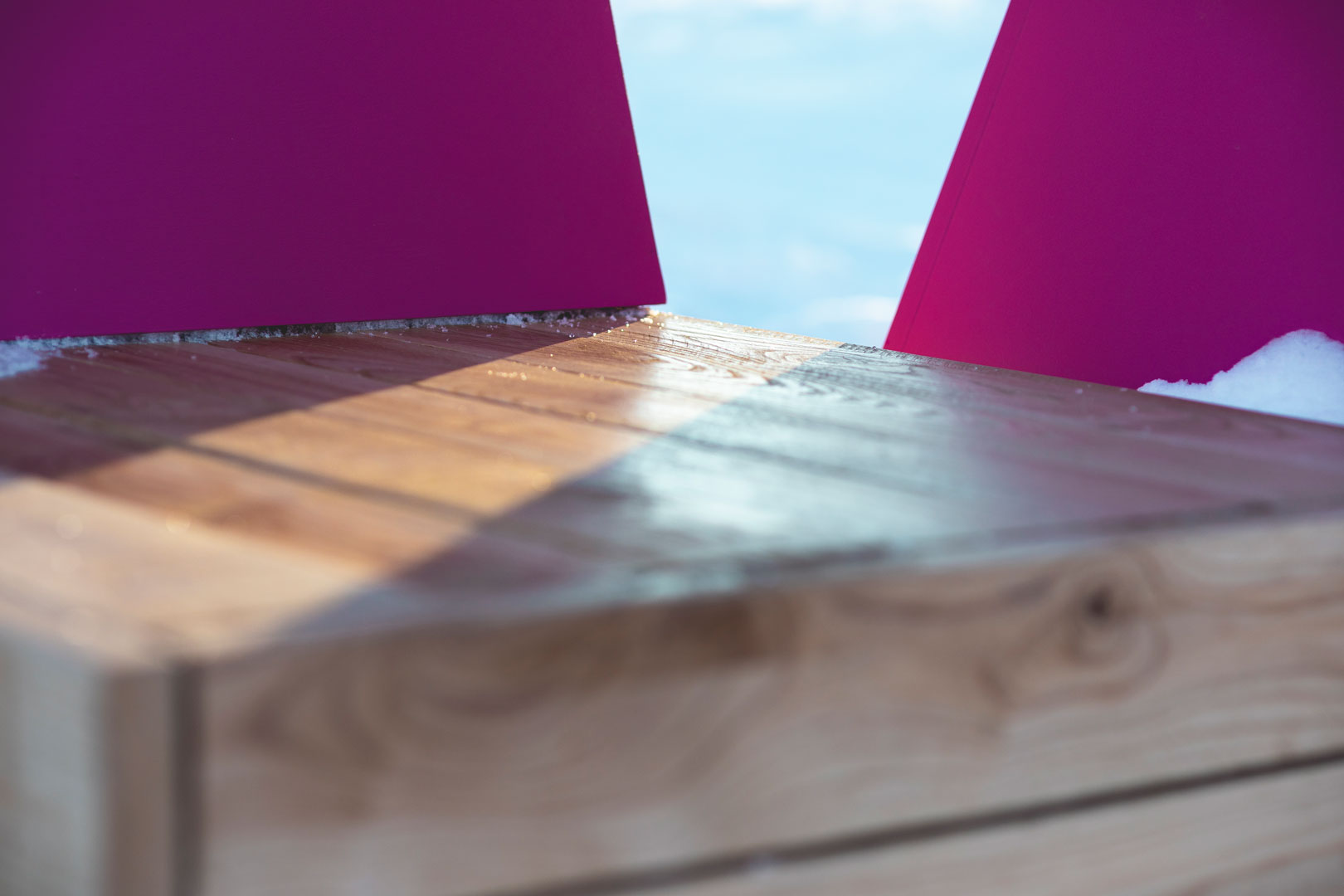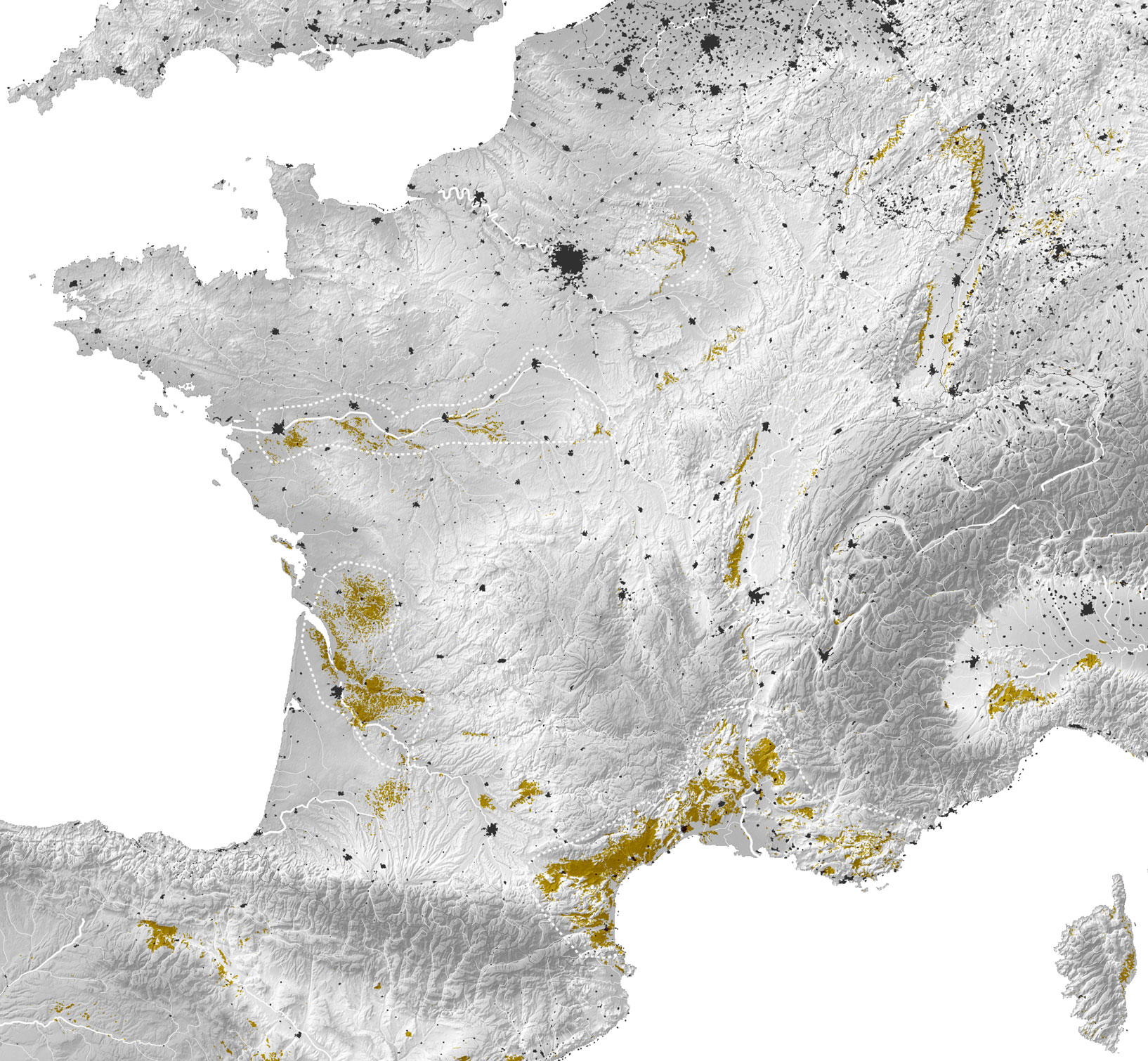VOIR L’HIVER EN ROSE
Location: Montreal, Canada
Program: Winter Station
Category: Built
Collaboration: Catherine Laroche, Camille Lasselin, and Ilot 84
Client: Arrondissement Saint Léonard
Year: 2020 - 2021
Photos by Charles-Olivier Bourque
On the Ladauversière Park trail, follow the symbolic conifers and immerse yourself in the heart of a bright forest that will have you seeing winter in pink! The winter station invites visitors to rediscover the park under its snowy cloak and offers a resting place near the shops of Jean-Talon East Street.
Program: Winter Station
Category: Built
Collaboration: Catherine Laroche, Camille Lasselin, and Ilot 84
Client: Arrondissement Saint Léonard
Year: 2020 - 2021
Photos by Charles-Olivier Bourque
On the Ladauversière Park trail, follow the symbolic conifers and immerse yourself in the heart of a bright forest that will have you seeing winter in pink! The winter station invites visitors to rediscover the park under its snowy cloak and offers a resting place near the shops of Jean-Talon East Street.
















THE
WOODS FELLOWSHIP
Location: Sudbury, Canada
Program: Urban Design Proposal
Category: Competition
Prize: Finalist
Collaboration: Daniela Leon, Christopher Alton
Year: 2020
Program: Urban Design Proposal
Category: Competition
Prize: Finalist
Collaboration: Daniela Leon, Christopher Alton
Year: 2020


















CARRÉ CASGRAIN




Existing condition, 2015 © Google
Location: Montréal, Canada Program: Community garden and event space Category: Volunteering Collaboration: Neighbours Council Year: 2017 -
The Carré Casgrain is a vacant lot with a story in the making. Initiated by dedicated local residents in 2017, the project began as a simple vegetable garden on a privately-owned vacant lot and evolved into a popular informal event space for three years in a row. The city now placed a ‘real-estate reserve’ and wants to buy and turn the land into a public park yet maintained and programmed by the residents. Following the spectacular destruction of the garden by the owner in 2019 as a retaliation strategy, this vacant lot exemplifies a grassroots way to bring neighbors together, gaining interest by local authorities and eventually creating new public space. Currently, the city is negotiating the purchase of the land with the owner, a process that can take between 2-4 years.
 facebook
facebook









PARIS SWINGS
Location: Paris, France
Program: Installation
Category: Competition
Collaboration: Camille Lasselin
Client: Maison d’Architecture d’Ile-de-France
Award: Laureat 1st Prize
- “Bonjour
- Hello”
This is the conversation that we can imagine between two users whether
they are from Morocco, Vietnam, Cameroon, or tourists. Facing each other and sitting on our own
swing, we can learn how to say hello in multiple languages. 
Nigthview at Barbès Metro Stop

Under the aerial metro
Swinging brings
us back to the poetry of childhood and saying hello to strangers breaks our prejudices
about people.
This is especially important in a Parisian neighborhood where foreigners represent between 15% to 25% of the population. The installation becomes a celebration of multiculturalism and tolerance.

Deployment of motif over five metro stations

Concept Diagram

“Hello” in the 25 most spoken languages of Paris
PUBLIC
TERROIRS
Location: Savennières, France
Program: Vineyard public space
Category: Master’s Thesis
Advisor: Gary Hilderbrand
Year: 2015-2016
From Territory to Terroir: Vineyard Public Space
The French concept of terroir claims that characteristics of place can be traced through a wine’s taste. Yet, today local characteristics tend to be overshadowed by the globalized wine-market where large corporations shape the production, distribution, and consumption of wine worldwide, creating wines with a uniform taste. In the Loire Valley, there is a counter current whereby a growing number of its vintners have reintroduced traditional and ecological growing techniques to bring out the true taste of the terroir in the wine.
Using site-specific and economical means, the thesis provides the rudiments for a shared public space. A seasonally-revolving public vineyard space expresses local rituals, site and soil particularities, and unique micro-climates. This public space fosters people’s understanding of the necessity for the particular in vineyard landscapes thus demonstrating how public vineyard space can express terroir.
Over 100 000 people per year migrate from urban to rural areas in France seeing the countryside as an attractive destination. Yet, this “neo-rural” lifestyle is disconnected from the surroundings and opportunities for exchange and understanding of viticulture are limited. This thesis vouches for developing vineyard public space through a deeper manifestation of terroir thus reconnecting locals with their surroundings. The vast territory of vineyard tracts in the Loire Valley is the ideal locus for a unique and temporal public space blending productive, ecological, didactic, and contemplative purposes. The vineyard becomes a complex public space--a space of exchange and strengthened social ties among producers, locals, consumers, and tourists--that offers a model for reordering the experience of the territory.
Program: Vineyard public space
Category: Master’s Thesis
Advisor: Gary Hilderbrand
Year: 2015-2016
From Territory to Terroir: Vineyard Public Space
The French concept of terroir claims that characteristics of place can be traced through a wine’s taste. Yet, today local characteristics tend to be overshadowed by the globalized wine-market where large corporations shape the production, distribution, and consumption of wine worldwide, creating wines with a uniform taste. In the Loire Valley, there is a counter current whereby a growing number of its vintners have reintroduced traditional and ecological growing techniques to bring out the true taste of the terroir in the wine.
Using site-specific and economical means, the thesis provides the rudiments for a shared public space. A seasonally-revolving public vineyard space expresses local rituals, site and soil particularities, and unique micro-climates. This public space fosters people’s understanding of the necessity for the particular in vineyard landscapes thus demonstrating how public vineyard space can express terroir.
Over 100 000 people per year migrate from urban to rural areas in France seeing the countryside as an attractive destination. Yet, this “neo-rural” lifestyle is disconnected from the surroundings and opportunities for exchange and understanding of viticulture are limited. This thesis vouches for developing vineyard public space through a deeper manifestation of terroir thus reconnecting locals with their surroundings. The vast territory of vineyard tracts in the Loire Valley is the ideal locus for a unique and temporal public space blending productive, ecological, didactic, and contemplative purposes. The vineyard becomes a complex public space--a space of exchange and strengthened social ties among producers, locals, consumers, and tourists--that offers a model for reordering the experience of the territory.
A seasonally-revolving public vineyard space expresses local rituals, site and soil particularities, and unique micro-climates.

French Wine Growing Regions & Cities
Source: Corine Land Cover, IGN

Public Network Plan - 1/2000


Existing and Proposed Rotational Cycles

Vineyard Parcels in 1958

Public Use Today

Public Use in 20+ Years

Public Use in 40+ Years

Harvest time is the single-most important event in the year.
Inhabiting a fallow parcel between the rows, La Place becomes a shared gathering space celebrating the harvest season and fostering unique social ties between vintners, seasonal workers, and locals.

Seasonal Variation of Groundcover within the Rows of Vines

La Coulée is a stream valley where fog and moisture are formed.
An intermittent boardwalk solidifies pre-existing desire lines and crosses the stream in distinct ways to experience the field, the marsh, and the forest of the moist valley.

Valley Section


A series of shallow terraces offer a flat surface for vintners to burn.
Using a non-planted parcel for burning allows for rejuvenation of the soil with the ashes from the cuttings. After a couple of years, the soil's organic matter is sufficient to replant.

Detail of Viewpoint











Copyright © Alexander Cassini 2020 | All rights reserved